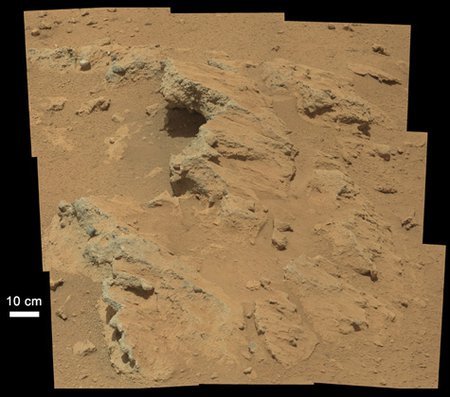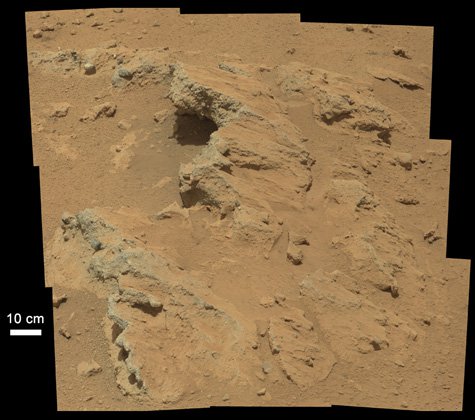An ankle- or hip-deep stream once flowed with force across the surface of Mars in the very spot where NASA's Curiosity rover is currently exploring. The finding, announced by members of the project's science team today at the Jet Propulsion Laboratory (JPL), provides new information about a once wet environment in Gale Crater, the ancient impact crater where the rover touched down in early August.
Using Curiosity's mast camera to analyze two rock outcrops known as Hottah and Link, the team has identified a tilted block of an ancient streambed—a layer of conglomerate rock, which is made up of stones of different sizes and shapes cemented together.
"Curiosity's discovery of an ancient streambed at Gale Crater provides confirmation of the decades-old hypothesis that Mars once had rivers that flowed across its surface," says John Grotzinger, the mission's project scientist and the Fletcher Jones Professor of Geology at Caltech. "This is the starting point for our mission to explore ancient, potentially habitable environments, and to decode the early environmental history of Mars."
The sizes of the gravels in the conglomerate rock suggest that the stream once flowed at a rate of about a meter per second. The discovery marks the first time scientists have identified gravel that was once transported by water on Mars.
In coming weeks and months, the team plans to use all of Curiosity's analytical instruments to study these types of rocks. And Grotzinger points out, "Finding geological evidence for past water is a prerequisite to beginning geochemical measurements that inform analysis of ancient potentially habitable environments. Curiosity has the most sophisticated and comprehensive suite of geochemical instruments ever flown to Mars."
For more about the finding, read the full JPL release.
 NASA's Curiosity rover found evidence for an ancient, flowing stream on Mars at a few sites, including the rock outcrop pictured here, which the science team has named Hottah after Hottah Lake in Canada's Northwest Territories. This geological feature on Mars is actually exposed bedrock made up of smaller fragments cemented together, or what geologists call a sedimentary conglomerate.
Credit: NASA/JPL-Caltech/MSSS
NASA's Curiosity rover found evidence for an ancient, flowing stream on Mars at a few sites, including the rock outcrop pictured here, which the science team has named Hottah after Hottah Lake in Canada's Northwest Territories. This geological feature on Mars is actually exposed bedrock made up of smaller fragments cemented together, or what geologists call a sedimentary conglomerate.
Credit: NASA/JPL-Caltech/MSSS

